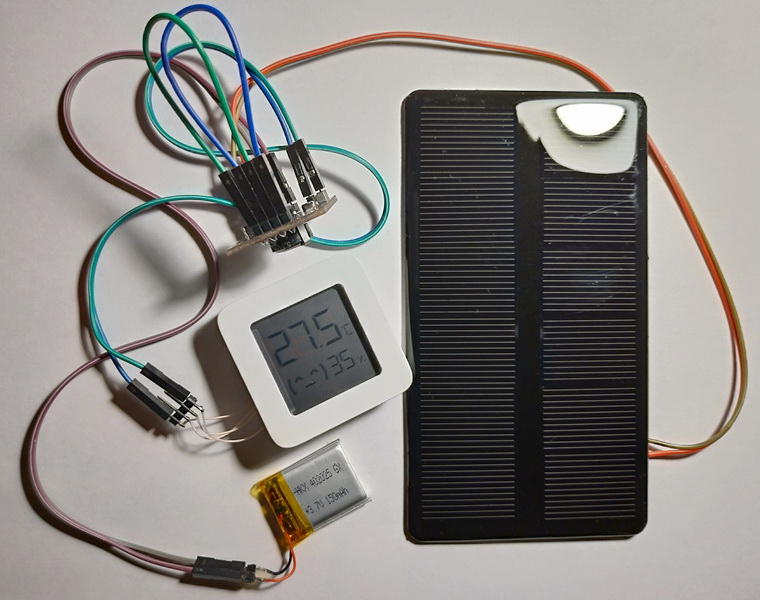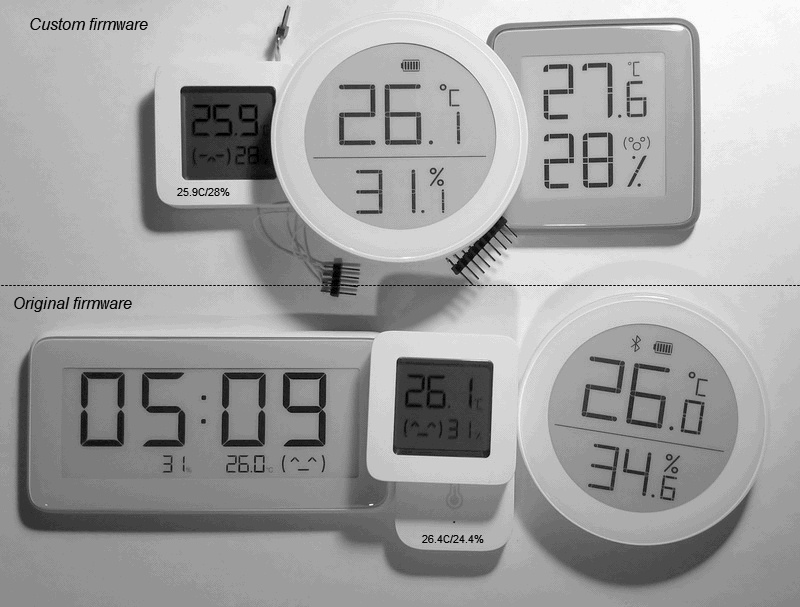Xiaomi Mijia (LYWSD03MMC) & Xiaomi Miaomiaoce (MHO-C401) & CGG1 Mijia Bluetooth Thermometer Firmware
This repository contains custom firmware for two Xiaomi Mijia Smart Bluetooth Thermometer & Hygrometer devices.
The custom firmware can be flashed via a modern browser and over-the-air (OTA) without opening the device and unlocks several customization options. You can go back to the original firmware at any time.
Key features
- Supports connections using PIN-code and encrypted bindkey beacon.
- 3 LCD Display Screens (Looping): Temperature & Humidity & Comfort, Temperature & Battery Level, Clock
- Measurement values recording & Charting. See Reading Measurements from Flash
- Adjustable correction offsets and Comfort zones
- Improved battery life
- Concurrent support for Xiaomi, ATC and Custom Bluetooth Advertisement format
- Adjustable RF TX Power & Bluetooth advertising interval
| Xiaomi Mijia (LYWSD03MMC) | Xiaomi Miaomiaoce (MHO-C401) | Qingping Temp & RH Monitor (CGG1-Mijia) |
|---|---|---|
Table of content
You can conveniently flash, update and configure the bluetooth thermometers remotely using a bluetooth connection and a modern web browser.
To flash or update the firmware, use a Google Chrome, Microsoft Edge or Opera Browser.
- Go to the Over-the-air Webupdater Page
TelinkMiFlasher.html* - If using Linux: Ensure you enabled "experimental web platform features". Therefore copy the according link (i.e.
chrome://flags/#enable-experimental-web-platform-featuresfor Chrome), open a new browser tab, paste the copied URL. Now sten the Experimental Web Platform features flag to Enabled. Then restart the browser. - In the Telink Flasher Page: Press
Connect: The browser should open a popup with visible Bluetooth devices. Choose the according target device (i.e.LYWSD03MMC) to pair. - After connection is established a Do Acivation button appears. Press this button to start the decryption key process.
- Now you can press the Custom Firmware ver x.x button to directly flash the custom firmware. Alternatively you can choose a specific firmware binary (i.e. the original firmware) via the file chooser
- Press Start Flashing.
- Use TelinkOTA to flash old or alternative versions (ATC1441). This is a program for OTA projects with Telink SDK, no third-party (mijia) protections.
After you have flashed the firmware, the device has changed it's bluetooth name to something like ATC_F02AED. Using the TelinkMiFlasher.html you have various configuration options.
General process:
- Press Connect
- Select the according device to connect/pair (i.e.
ATC_F02AED) - Several configuration options appear
- Choose Send Config to send changed value to the device. Or press Set default and then Send config to revert to the Defaults
| Option | Description |
|---|---|
| Temperature and Humidity offset | Enter a value to correct the offset of the Temperature or Humidity displayed: For example -1.4 will decrease the Temperature by 1.4° |
| Smiley or Comfort | Choose a static smiley or check the "Comfort" Radio box to change the smiley depending on current Temperature and Humidity. |
| Comfort Parameters | Defines the Lower (Lo) and Upper (Hi) Range for Temperature and Humidity interpreted as comfort zone. In the default configuration a smiley will appear. |
| Advertising Type | Type of supported Bluetooth Advertising Formats. By default all formats are enabled. |
| Set time | sends the current time to the device |
| Comfort, Show batt, Clock | Ticking the according boxes you can enable interval rotation between different LCD screens. See the example video below. |
Example of LCD display modes
You can configure different LCD Display modes using Comfort, Show batt and Clock configuration checkboxes. The enabled LCD Display Modes will appear one-by-one in a loop.
Battery and clock display are enabled in the settings. The rest of the settings is kept default. The video contains 2 cycles.
- Temperature and humidity
- Temperature and % of battery
- Temperature and humidity
- Hours and minutes
You can directly update/flash the firmware without downloading the binaries below.
Custom Firmware Versions:
- LYWSD03MMC Custom Firmware Version 3.1
- MHO-C401 Custom Firmware Version 3.1
- CGG1 Custom Firmware Version 3.1
Original Manufacturer Firmware Version
In case you want to go back to the original firmware, you can download them here:
- LYWSD03MMC Original Firmware v1.0.0_0109
- MHO-C401 Original Firmware v1.0.0_0010
- CGG1 Original Firmware v1.0.1_0093
| Version | Changes |
|---|---|
| 1.2 | Bind, Set Pin-code, Support MHO-C401 |
| 1.3 | Get/Set comfort parameters |
| 1.4 | Get/Set device name, Get/Set MAC |
| 1.5 | Add Standard Device Information Characteristics |
| 1.6 | Fix alternation of Advertising in mi mode |
| 1.7 | Authorization and encryption in permissions to access GAP ATT attributes, if pin code is enabled |
| 1.8 | Time display (instead of a blinking smile) |
| 1.9 | Recording measurements to flash memory (cyclic buffer for 19632 measurements) |
| 2.0 | Recording measurements with averaging to flash memory |
| 2.1 | Periodic display refresh for MHO-C401 'Erase mi-keys' option to return to original firmware |
| 2.2 | Added parameter "Encrypted Mi Beacon" |
| 2.3 | Added "Delete all records" |
| 2.4 | Added parameter "Clock time step" |
| 2.5 | Remove TRG/FLG errors, minor optimization |
| 2.6 | Expanding the ranges of threshold parameters (TRG) |
| 2.7 | Reducing power consumption of MHO-C401 (EDP update), adding version for CGG1 |
| 2.8 | Added saving bindkey to EEP if mi-keys are erased, reduced TX power to 0 dB for defaults |
| 2.9 | Added additional id flags to advertising packages |
| 3.0 | Added toggle support for advertising package structures for third-party software |
| 3.1 | Fix security attributes for pincode |
GraphAtc.html GraphAtc1.html GraphAtc2.html DevPoint.html
This requires the Experimental Web Platform Features flag enabled in your browser. See Flashing or Updating the Firmware (OTA).
Xiaomi Mijia (LYWSD03MMC)
Using the default settings for advertising interval of 2.5 seconds and measurement interval of 10 seconds:
- Bluetooth Advertisement: 15..20 uA 3.3V (CR2032 over 6 months)
- Bluetooth Connection: 14..25 uA 3.3V (CR2032 over 6 months)
Xiaomi Miaomiaoce (MHO-C401)
Using the default settings for advertising interval of 2.5 seconds and measurement interval of 20 seconds:
- Bluetooth Advertisement: 12..30 uA 3.3V (depends on the amount of temperature or humidity changes over time to display)
- Bluetooth Connection: 15..30 uA 3.3V (depends on the amount of temperature or humidity changes over time to display)
The Firmware can be configured to support one of four different Bluetooth advertisements data formats. Supports bindkey beacon encryption.
You can also configure to transferring everything in turn (round-robin)
UUID 0x181A - size 16: atc1441 format
UUID 0x181A - size 19: Custom format (all data little-endian):
uint8_t size; // = 19
uint8_t uid; // = 0x16, 16-bit UUID
uint16_t UUID; // = 0x181A, GATT Service 0x181A Environmental Sensing
uint8_t MAC[6]; // [0] - lo, .. [6] - hi digits
int16_t temperature; // x 0.01 degree
uint16_t humidity; // x 0.01 %
uint16_t battery_mv; // mV
uint8_t battery_level; // 0..100 %
uint8_t counter; // measurement count
uint8_t flags; // GPIO_TRG pin (marking "reset" on circuit board) flags:
// bit0: GPIO_TRG pin input value (real level)
// bit1: GPIO_TRG pin output value (pull Up/Down)
// bit2: Output GPIO_TRG pin is controlled according to the set parameters
// bit3: Temperature trigger event
// bit4: Humidity trigger event- UUID 0xFE95 - 0x0A: Xiaomi - battery charge level 0..100%, battery voltage in mV
- UUID 0xFE95 - 0x0D: Xiaomi - temperature x0.1C, humidity x0.1%
- UUID 0xFE95 - 0x0A, 0x04, 0x06 Xiaomi - battery charge level 0..100%, temperature x0.1C, humidity x0.1% (All data are averaged over a period of 16 measurements)
- Primary Service - Environmental Sensing Service (0x181A):
- Characteristic UUID 0x2A1F - Notify temperature x0.1C
- Characteristic UUID 0x2A6E - Notify temperature x0.01C
- Characteristic UUID 0x2A6F - Notify about humidity x0.01%
- Primary Service - Battery Service (0x180F):
- Characteristic UUID 0x2A19 - Notify the battery charge level 0..99%
- Primary Service (0x1F10):
- Characteristic UUID 0x1F1F - Notify, frame id 0x33 (configuring or making a request): temperature x0.01C, humidity x0.01%, battery charge level 0..100%, battery voltage in mV, GPIO-pin flags and triggers.
Hysteresis:
- =0 off,
- if less than zero - activation on decrease,
- if more than zero - activation on excess
Setting the pin to "1" or "0" works if both hysteresis are set to zero (TRG off).
- LCD shows:
- Big number: -99.5..1999.5
- Small number: -9..99
- Smiley, battery, degrees
- Setting the display time limit in sec
- Connect only TX-SWS and GND wires.
- TLSR8251F512ET24 (TLSR8258 in 24-pin TQFN). SoC: TC32 32-bit MCU 48Mhz, 64 KiB SRAM, 512 KiB Flash (GD25LE40C), Bluetooth 5.0: Mesh, 6LoWPAN, Zigbee, RF4CE, HomeKit, Long Range, Operating temperature: -40°C to +85°C, Power supply: 1.8V to 3.6V.
- SHTV3 sensor. Measurement range: Temperature -40°C to +125°C, Humidity 0 to 100 %RH. Power supply: 1.8V to 3.6V
- IST3055NA0 LCD controller
- Go to wiki.telink-semi.cn and get the IDE for TLSR8 Chips.
- Clone https://github.com/Ai-Thinker-Open/Telink_825X_SDK
- Install the IDE and import the 'ATC_MiThermometer' project
- Change 'Linked resource' and 'C/C++ Build/Build command'.
- Compile the project
ATC_MiThermometer is based on the original work of @atc1441, who developed the initial custom firmware version and the web-based OTA flasher (Source).
-
Alternative programmer TLSR SWire on module TB-04/03F or E104-BT10
-
Additional information on the format Advertising for Xiaomi LYWSD03MMC
| ID | Command |
|---|---|
| 0x01 | Get/Set device name |
| 0x10 | Get/Set MAC |
| 0x11 | Get/Set Mi key: DevNameID |
| 0x12 | Get/Set Mi keys: Token & Bind |
| 0x15 | Get all Mi keys |
| 0x16 | Restore prev mi token & bindkeys |
| 0x17 | Delete all Mi keys |
| 0x18 | Get/set binkey in EEP |
| 0x20 | Get/Set comfort parameters |
| 0x22 | Get/Set show LCD ext.data |
| 0x23 | Get/Set Time |
| 0x24 | Get/set adjust time clock delta |
| 0x33 | Start/Stop notify measures in connection mode |
| 0x35 | Read memory measures |
| 0x36 | Clear memory measures |
| 0x44 | Get/Set TRG config |
| 0x45 | Set TRG output pin |
| 0x4A | Get/Set TRG data (not save to Flash) |
| 0x55 | Get/Set device config |
| 0x56 | Set default device config |
| 0x5A | Get/Set device config (not save to Flash) |
| 0x60 | Get/Set LCD buffer |
| 0x61 | Start/Stop notify LCD buffer |
| 0x70 | Set PinCode |
| 0x71 | Request Mtu Size Exchange |









